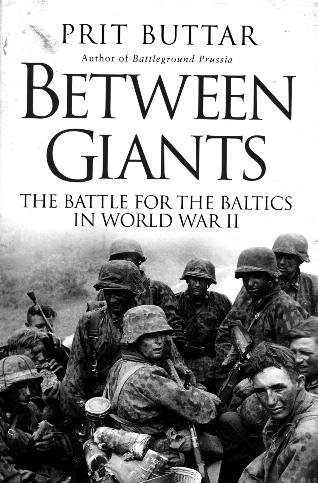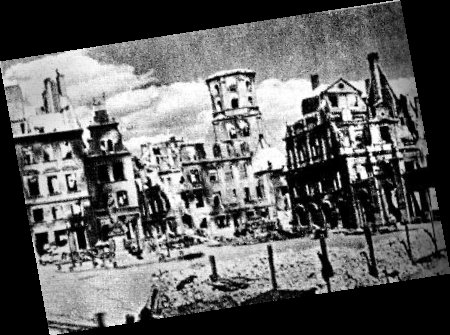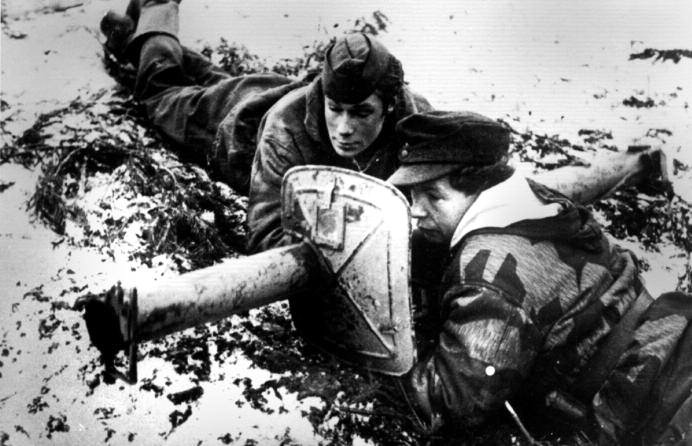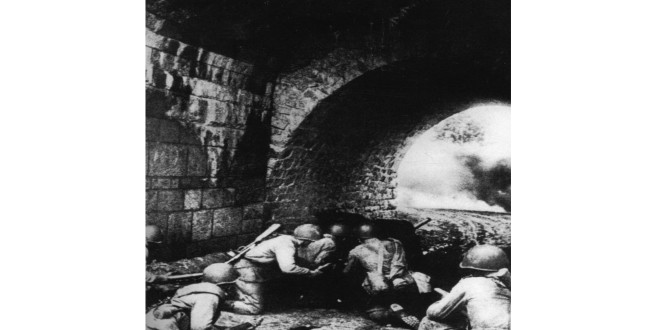By GEDIMINAS INDREIKA.

History books by American authors rarely touch upon the subject of how the Baltic States became the victims of the Soviet Union’s aggression. Lithuanians educated in the Soviet era often do not understand their nation’s past because the history they were taught was deliberately distorted, portraying Russia as the source of civilization in Eastern Europe and heralding World War II as “the Great Patriotic War.” Lithuania’s historians unfortunately have failed to produce a comprehensive and accurate history of Lithuania during World War II. This is why I consider it truly a blessing that Prit Buttar has finally written a concise, almost definitive history of the Baltic States in this critical period.
Buttar’s “Between Giants: the Battle for the Baltics in World War II” (New York, Osprey, 2013) tells the story of the fight for survival by Lithuania, Latvia and Estonia amidst the formidable military machine of the Soviet Union and the Third Reich. A physician general practioner in the British Army, Dr. Buttar is also an independent military historian. His first book “Battleground Prussia: the Assault on Germany’s Eastern Front” was published in 2010. “Between Giants” is primarily a war book as it chronicles the military and political battles of the Soviet Union and Germany. Buttar sheds light on the private characters of Stalin and Hitler, and how the rivalry between these two evil emperors unleashed a reign of terror that led to the killing and torture of millions of people and the redrawing of the map of Europe.
The Molotov-Ribbentrop Pact, signed in Moscow on August 23, 1939, was made public except for the secret protocols defining territory and the spheres of influence. On September 28 the protocols were revised, consigning Lithuania to the Soviet sphere of influence. On the same day that the pact was signed, Josef Stalin went on a duck hunt with his closest associates, telling them, “Of course it’s all a game to see who can fool whom. I know what Hitler’s up to. He thinks he’s outsmarted me but actually it’s I who’s tricked him.” (p. 31)
The Estonian government was caught off guard by the development of the pact, till then it debated about whom they would support – Germany or the Soviet Union. Suddenly the two opposing powers were friends. On September 27, 1939, Moscow demanded that Estonia sign a “Pact of Mutual Assistance,” by which 25,000 Soviet troops would be stationed on Estonian territory – a greater number than the total troops in Estonia’s Armed forces. It demanded location of Soviet naval bases on two Estonian islands. A few weeks later the Soviet Union used these bases to launch its attack on Finland in the Winter War.

On October 3, 1939, Moscow made similar demands for military garrisons in Lithuania, in the guise of an almost identical mutual assistance pact. The Soviets had already seized Vilnius from its Polish occupants. To sweeten the deal, the Soviets offered to cede this historic capital and its region back to Lithuania.
Once their heavy armor rolled into Lithuania,the Soviets proceeded in their master plan to destroy the independence of the Baltic nations. They fabricated accusations that Lithuanians kidnapped two of their soldiers in the garrison, so that they could escalate the crisis. During the night of June 14-15, 1940, Molotov served an ultimatum to Lithuania’s Foreign Minister Urbsys, demanding that an unlimited number of additional Red Army troops be allowed to enter Lithuania to enforce the provisions of the “Pact of Mutual Assistance.”
Buttar does not present a full picture of the events that transpired the nightthe Soviet ultimatum was served, at the fateful all night conference of Lithuanian President Smetona’s administration. Prime Minister Merkys, his aide Bizauskas, Defense Minister Musteikis, Interior Minister Skucas and others frantically deliberated with the President on whether to accept Moscow’s ultimatum. Curiously, the author does not mention Vincas Vitkauskas, the Commander-in-Chief of Lithuania’s Armed forces, who at this conference argued that it was hopeless to resist the Soviets. On the day of the occupation on June 15, 1940, General Vitkauskas ordered his soldiers to meet the Red Army “in accordance with the generally accepted guidelines of politeness and friendship.” Vitkauskas was named the new Minister of Defense by the Soviet occupation regime. Buttar also does not mention Stasys Lozoraitis, who was designated by President Smetona to be chief of the Lithuanian diplomatic service “if Lithuania should meet with a catastrophe” in order to maintain the continuity of the independent Lithuanian State. (Lozoraitis remained in Rome as Plenipotent Minister to the Vatican and was recognized as the de jure representative of Lithuania).
All three leaders of the Baltic States were deported to Russia while they werecitizens of still formally independent states: Antanas Merkys, the acting President of Lithuania, on July 22; next Karlis Ulmanis of Latvia, on July 30; and finally Konstantin Pats, the President of Estonia, on July 30. President Ulmanis died in captivity in 1942.
Stalin completely misjudged Hitler at the start of Operation Barbarossa, as he expected the Germans would need 15 days to prepare for war. His advisors briefed him on the impending invasion, but Stalin dismissed those reports. Beginning on June 22, 1941, the Luftwaffe launched air strikes on Lithuanian territory. The author expertly describes these attacks with play-by-play commentary and logistical maps.

The German 291st Infantry swiftly broke through the Russian defenses in Lithuania, pushing on to reach Latvia. Much of the Russian 67th Rifle division was wiped out. The Soviet counterattack had fizzled. The Red Army chaotically retreated back into Russia. Entire companies of Lithuanian soldiers, whose units were integrated into the Red Army, either deserted en masse or turned against the Soviets.
Buttar shows empathy in his portrayal of Lithuanians who initially welcomed the Germans as liberators. The Lithuanian Activist Front organized a revolt against the Soviets on June 23, 1941, a day before the Wehrmacht reached Kaunas. The Lithuanian Provisional Government, led by Juozas Ambrazevicius, declared independence and was in control of the city for a few weeks. The Germans did all they could to block its development and obstructed access to the radio station. The Germans did not allow self-determination for Lithuania, establishing their own regime, now part of Reichskommissariat Ostland.
Chapter 4 is devoted to the Baltic Holocaust. In June 1941, Hitler informed his generals that “Bolsheviks, agitators, partisans, saboteurs and Jews must all be treated as potential enemies.” Wehrmacht units were ordered to compile lists of all Jews in their areas and to hand them to the Einsatzgruppen (task forces). The Germans sought to use Lithuanian police units (Tautos Darbo Apsauga) to carry out their policy of exterminating Jewish people. Two police battalions were assigned to Einsatzgruppen 3A at Fort VII near Kaunas. One battalion was ordered to guard the Jews who were in custody, the other carried out the executions under German supervision.
The most notorious Holocaust site in Lithuania is the forest of Paneriai, 16 km. southwest of Vilnius. Between July 1941 and 1944 there were 80,000 people killed here and dumped into a mass grave, most of them Jews. Buttar provides eyewitness accounts by a survivor of this massacre, Tamara Katz, and by one perpetrator of the crimes, a German soldier.
By 1944 the Reich’s leadership began to view the Baltic nationals as a source of front-line troops to fight the Red Army as it pushed back West. Knowing what the return of Soviet power would mean, a good number of Latvians and Lithuanians were compelled to choose between what they deemed to be the lesser of two evils. Unlike their neighbors to the North, Lithuanians refused to form any Waffen SS battalions.
In February 1944 the Central Council of Latvia (Latvijas Centrala Padome) led by K. Cakste adopted its platform to resist both Soviet and German occupying powers. A home guard regiment led by Janis Kurelis was formed to fight against Soviet re-occupation. On September 14, 1944, Soviet forces led by Ivan Bagramian attacked Latvia from the north, driving towards Riga. By October 1 the Red Army took Palanga and Telšiai from Lithuania, cutting off the Army Group North in Courland from the German divisions in East Prussia and in Klaipėda. Supplies for the several hundred thousand troops isolated in Latvia’s “Courland Pocket” from now on were to be delivered via the Baltic Sea. One photograph in the book depicts wood barrels filled with supplies floating near the coastline. Against all odds, Latvian soldiers armed by Germans – Latvijas Sargi, and German soldiers fought the fierce battles for the Courland bridgehead for nine months during Operation Zeppelin and Operation Wildkatze. The incredible saga of Latvian soldiers holding out in the last year of the war, delaying the Soviet subjugation of their homeland, in my opinion, is the highlight of Buttar’s book (Chapter 10).
“Between Giants” is meticulously researched and supported by extensive footnotes. The author skillfully utilizes archival materials in his narrative and does not bore the reader with cumbersome statistics. Although “Between Giants” falls short of being a complete history of the Baltic States in World War II, it is definitely the most readable and objective book on the subject in English available today. “Between Giants” is highly recommended to fans of military history and to serious scholars of Baltic history.
 DRAUGAS NEWS Lithuanian World Wide News in English
DRAUGAS NEWS Lithuanian World Wide News in English
